The Origins of Sulfate in Cenozoic Non-Marine Evaporites in the Basin and-Range Province, Southwestern North America
Abstract
:1. Introduction
1.1. Study Context and Scope
1.2. Study Area
1.2.1. Picacho Basin
1.2.2. Tucson Basin
1.2.3. San Pedro Basin
1.2.4. Safford Basin
1.2.5. Unnamed Basin, Douglas
1.2.6. Modern Playas
1.3. Environment of Evaporite Formation
1.4. Origins of Sulfur in Non-Marine Evaporites
1.5. Evolution of δ34S and δ18O in Sulfate Evaporites
1.6. Previous Geochemical and Isotope Studies of Nonmarine Evaporites in Southwest North America
1.7. Sulfate Isotopes in Precipitation
1.8. Bedrock Sulfate and Sulfide
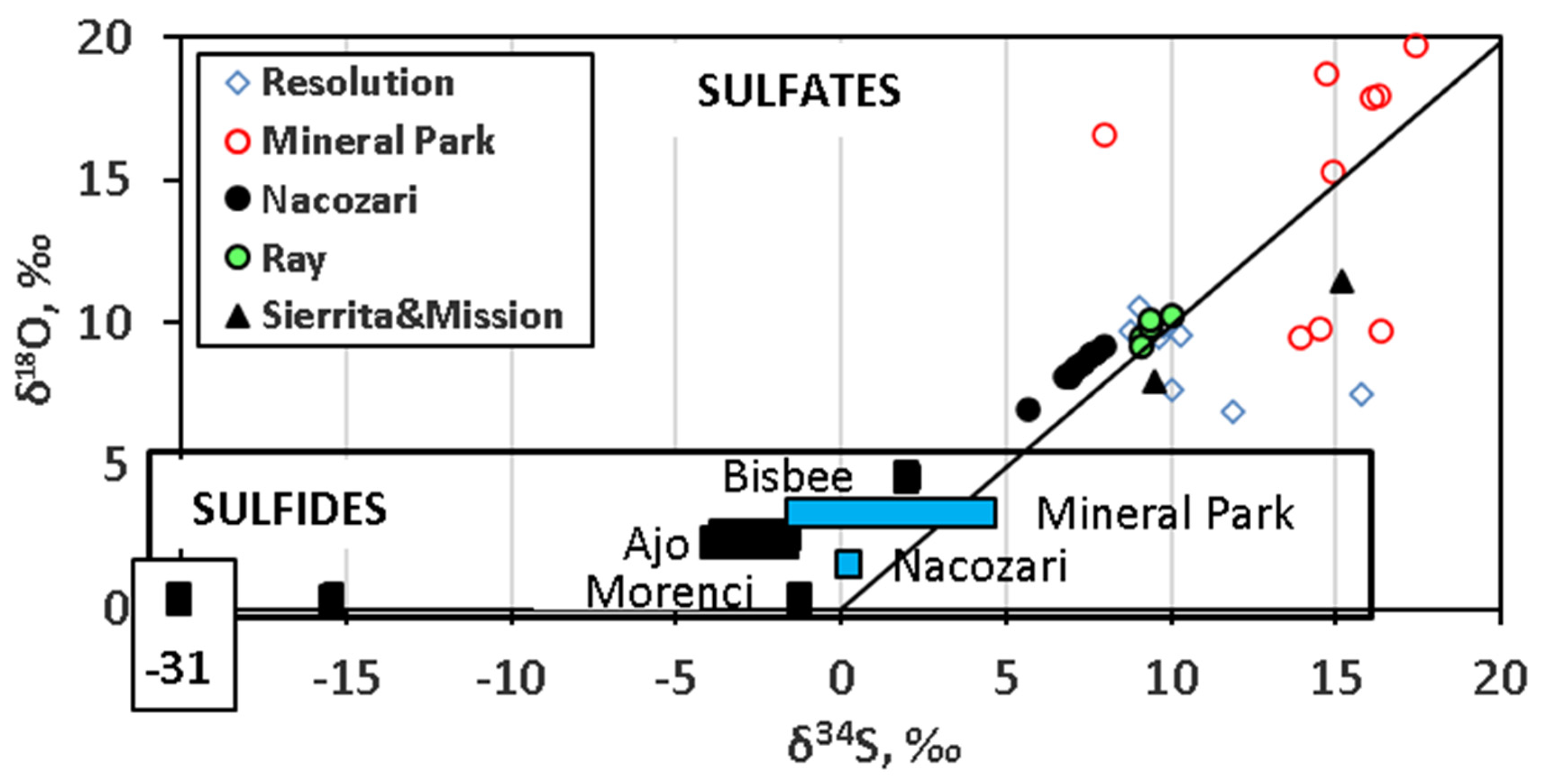
| Rock-Type | Location | Material | δ34S | δ18O | Source |
|---|---|---|---|---|---|
| ‰ | ‰ | ||||
| Laramide igneous | Tucson Mts. | GW | +1 to +3 | [63] | |
| Laramide igneous | Patagonia Mts. | ARD | −10.7 to +0.1 | −2 to +2 | [63,69,70] |
| Jurassic igneous | Sta. Rita Mts., Tucson basin | GW | +1 to +3 | [84] | |
| Permian marine evaporite | Whetstone Mts. | gypsum | +11.7 | +12.8 | [63] |
| Permian marine evaporite | Tusayan, Colorado Plateau | gypsum | +13 | [73] | |
| Proterozoic/Eocene granitic gneiss | Rincon Mts., Tucson Basin | GW, high-SO4 * | +8.5 to +10.3 | −0.8 to +2.0 | [63] |
| Proterozoic/Eocene granitic gneiss | Rincon Mts., Tucson Basin | GW, low-SO4 # | +2.4 to +12.1 | +3.5 to +10.3 | E |
| Proterozoic/Eocene granitic gneiss | Sta.Catalina Mts., Tucson Basin | GW | +3 to +9 | +4 to +11 | [68] |
| Proterozoic Pioneer shale | Sta.Catalina Mts., Tucson Basin | pyrite | +25.5, +25.7 | this study | |
| Proterozoic Pioneer shale | Sta.Catalina Mts., Tucson Basin | jarosite | 17.8 | −0.1 | this study |
| Proterozoic Pioneer shale | Sta.Catalina Mts., Tucson Basin | jarosite | 25.1 | 1.0 | this study |
| Proterozoic Pioneer shale | Sta.Catalina Mts., Tucson Basin | jarosite | 18.3 | −1.1 | this study |
| Proterozoic felsic volcanic rock | Central Arizona | VMS | 0 ± 3 | [85] |
2. Materials and Methods
3. Results
4. Discussion
4.1. Sources of Sulfur, Principal Controls
4.2. Sources of Sulfur, Picacho Basin
4.3. Sources of Sulfur, Safford Basin
4.4. Sources of Sulfur, Gypsum with δ34S > 10‰
4.5. Bristol Dry Lake and Death Valley
4.6. Episodes of Evaporite Formation
4.7. Evaporite Evolution
4.8. Study Significance and Future Research
5. Conclusions
Supplementary Materials
Author Contributions
Funding
Data Availability Statement
Acknowledgments
Conflicts of Interest
References
- Eckardt, F.D. The origin of sulphates: An example of sulphur isotopic applications. Prog. Phys. Geog. 2001, 25, 512–519. [Google Scholar] [CrossRef]
- Pearson, F.J.; Rightmire, C.T. Sulfur and oxygen isotopes in aqueous sulfur compounds. In Handbook of Environmental Isotope Geochemistry, Vol. 1, The Terrestrial Environment A; Fritz, P., Fontes, J.C., Eds.; Elsevier: Amsterdam, The Netherlands, 1980; pp. 227–258. [Google Scholar]
- Krouse, H.R.; Grinenko, V.A. Stable Isotope, Natural and Anthropogenic Sulphur in the Environment (SCOPE Series); John Wiley: Hoboken, NJ, USA, 1991. [Google Scholar]
- Claypool, G.E.; Holser, W.T.; Kaplan, I.R.; Sakai, H.; Zak, I. The age curves of sulfur and oxygen isotopes in marine sulfate and their mutual interpretation. Chem. Geol. 1980, 28, 199–260. [Google Scholar] [CrossRef]
- Utrilla, R.; Pierre, C.; Orti, F.; Pueyo, J.J. Oxygen and sulphur isotope compositions as indicators of the origin of Mesozoic and Cenozoic evaporates from Spain. Chem. Geol. 1992, 102, 229–244. [Google Scholar] [CrossRef]
- Attia, O.E.; Lowenstein, T.K.; Wali, S.M.A. Middle Miocene gypsum, Gulf of Suez: Marine or non-marine? J. Sed. Res. 1995, A65, 614–626. [Google Scholar]
- Palmer, M.; Helvaci, C.; Fallick, A.E. Sulphur, sulphate oxygen and strontium isotope composition of Cenozoic Turkish evaporites. Chem. Geol. 2004, 209, 341–356. [Google Scholar] [CrossRef]
- Fontes, J.C.; Letolle, R. 18Oand 34S in the Upper Bartonian gypsum deposits of the Paris basin. Chem. Geol. 1976, 18, 285–295. [Google Scholar] [CrossRef]
- Chivas, A.R.; Andrew, A.S.; Lyons, W.B.; Bird, M.I.; Donnelly, T.H. Isotopic constraints on the origin of salts in Australian playas. 1. Sulphur. Palaeogeogr. Palaeoclimatol. Palaeoecol. 1991, 84, 309–322. [Google Scholar] [CrossRef]
- Eckardt, F.D.; Spiro, B. The origin of sulphur in gypsum and dissolved sulphate in Central Namib Desert, Namibia. Sed. Geol. 1999, 123, 255–273. [Google Scholar] [CrossRef]
- Holser, W.T.; Kaplan, I.R. Isotope geochemistry of sedimentary sulfates. Chem. Geol. 1966, 1, 93–135. [Google Scholar] [CrossRef]
- Eugster, H.P. Geochemistry of evaporitic lacustrine deposits. Ann. Rev. Earth Plan. Sci. 1980, 8, 35–63. [Google Scholar] [CrossRef]
- Fenneman, N.M. Physiography of Western United States, 1st ed.; McGraw-Hill: New York, NY, USA, 1931. [Google Scholar]
- Peirce, H.W. Tectonic significance of Basin and Range thick evaporite deposits. Ariz. Geol. Soc. Digest 1976, 10, 325–339. [Google Scholar]
- Bohannon, R.C. Nonmarine Sedimentary Rocks of Tertiary Age in the Lake Mead Region, Southwestern Nevada and Northwestern Arizona; US Geological Survey Professional Paper 1259; United States Government Publishing Office: Washington, DC, USA, 1984.
- Faulds, J.E.; Schreiber, B.C.; Reynolds, S.J.; Gonzalez, L.A.; Maya, D. Origin and paleography of an immense, nonmarine Miocene salt deposit in the Basin and Range (Western USA). J. Geol. 1997, 105, 19–36. [Google Scholar] [CrossRef]
- Miranda-Gasca, M.A.; Gomez-Caballero, J.A.; Eastoe, C.J. Borate deposits of northern Sonora, Mexico: Stratigraphy, tectonics, stable isotopes, and fluid inclusions. Econ. Geol. 1998, 93, 510–523. [Google Scholar] [CrossRef]
- Fisher, R.S.; Mullican, W.F., III. Integration of Ground-Water and Vadose-Zone Geochemistry to Investigate Hydrochemical Evolution: A Case Study in Arid Lands of Northern Chihuahuan Desert, Trans-Pecos Texas; Geological Circular 90-5; Bureau of Economic Geology, University of Texas at Austin: Austin, TX, USA, 1990. [Google Scholar]
- Buck, B.J.; Van Hoesen, J.G. Assessing the applicability of isotopic analysis of pedogenic gypsum as a paleoclimate indicator, southern New Mexico. J. Arid Environ. 2005, 60, 99–114. [Google Scholar] [CrossRef]
- Eberly, D.; Stanley, B., Jr. Cenozoic stratigraphy and geological history of southwestern Arizona. Geol. Soc. Am. Bull. 1978, 89, 921–940. [Google Scholar] [CrossRef]
- Anderson, S.R. Cenozoic Stratigraphy and Geologic History of the Tucson Basin, Pima County, Arizona; US Geological Survey Water-Resources Investigations Reports 874190; Department of the Interior, US Geological Survey: Reston, VA, USA, 1987.
- Harris, R.C. Distribution of Evaporites and Implications for Water Quality in the San Carlos-Safford-Duncan non-Point Source Management Zone; Arizona Geological Survey Open-File Report 97-03; Arizona Geological Survey: Tucson, AZ, USA, 1997. [Google Scholar]
- Eaton, G.P.; Peterson, D.L.; Schumann, H.H. Geophysical, Geohydrological, and Geochemical Reconnaissance of the Luke Salt Body, Central Arizona; US Geological Survey. Professional Paper 753; United States Government Publishing Office: Washington, DC, USA, 1972.
- Dean, W.E.; Johnson, K.S. Anhydrite Deposits of the United States and Characteristics of Anhydrite Important for Storage of Radioactive Wastes; US Geological Survey Bulletin 1974; US Geological Survey: Reston, VA, USA, 1989.
- Richard, S.M.; Shipman, T.C.; Greene, L.C.; Harris, R.C. Estimated Depth to Bedrock in Arizona; Arizona Geological Survey Digital Geologic Map DGM-52; Arizona Geological Survey: Tucson, AZ, USA, 2007. [Google Scholar]
- Dickinson, W.R. The Basin and Range Province as a composite extensional domain. Int. Geol. Rev. 2002, 44, 1–38. [Google Scholar] [CrossRef] [Green Version]
- Anderson, T.W.; Freethey, G.W.; Tucci, P. Geohydrology and Water Resources of Alluvial Basins in South-Central Arizona and Parts of Adjacent States; US Geological Survey. Professional Paper 1406 B; United States Government Printing Office: Washington, DC, USA, 1992.
- Peirce, H.W. Thick evaporites in the Basin and Range Province—Arizona. In 4th Symposium on Salt; Northern Ohio Geological Society: Cleveland, OH, USA, 1974; pp. 47–55. [Google Scholar]
- Oppenheimer, J.M.; Sumner, J.S. Gravity modeling of the basins in the Basin and Range Province, Arizona. Ariz. Geol. Soc. Digest 1981, 13, 111–115. [Google Scholar]
- Pool, D.R.; Carruth, R.L.; Meehan, W.D. Hydrogeology of Picacho Basin, South-Central Arizona; US Geological Survey Water-Resources Investigations Reports. 00-4277; United States Government Printing Office: Washington, DC, USA, 2001.
- Dickinson, W.R. Facies Map of Post-Mid-Miocene Quiburis Formation, San Pedro trough, Pinal, Pima, Gila, Graham, and Cochise Counties, Arizona; Arizona Geological Survey Contributed Map CM-98-A; Arizona Geological Survey: Tucson, AZ, USA, 1998. [Google Scholar]
- Gray, R.S. Late Cenozoic Sediments in the San Pedro Valley Near St. David, Arizona. Master’s Thesis, University of Arizona, Tucson, AZ, USA, 1965. [Google Scholar]
- Dickinson, W.R. Tectonic Setting of Faulted Tertiary Strata Associated with the Catalina Core Complex in Southern Arizona; Geological Society of America Special Paper 264; Geological Society of America: Boulder, CO, USA, 1991. [Google Scholar]
- Kruger, J.M. Seismic Crustal Structure Beneath the Safford Basin and Pinaleno Mountains: Implications for Cenozoic Extension and Metamorphic Core Complex Uplift in SE Arizona. Ph.D. Thesis, University of Arizona, Tucson, AZ, USA, 1991. [Google Scholar]
- Kruger, J.M.; Johnson, R.A.; Houser, B.B. Miocene-Pliocene half-graben evolution, detachment faulting and late-stage core complex uplift from reflection seismic data in southeast Arizona. Basin Res. 1995, 7, 129–149. [Google Scholar] [CrossRef]
- Houser, B.B. Late Cenozoic stratigraphy and tectonics of the Safford, Tonto, and Payson basins, southeastern and central Arizona. In Geological Excursions through the Sonoran Desert Region, Arizona and Sonora; Arizona Geological Survey Special Paper 7; Gehrels, G.E., Spencer, J.E., Eds.; Arizona Geological Survey: Tucson, AZ, USA, 1990; pp. 20–24. [Google Scholar]
- Houser, B.B.; Richter, D.H.; Shafiqullah, M. Geological Map of the Safford Quadrangle, Graham County, Arizona; US Geological Survey Misc. Inv. Ser. Map 1-1617; United States Government Printing Office: Washington, DC, USA, 1985.
- Schreiber, B.C.; Hsu, K.J. Evaporites. In Developments in Petroleum Geology; Vol. 2. Hobson, G.D., Ed.; Applied Science Publishers: Essex, UK, 1980; Volume 2, pp. 87–138. [Google Scholar]
- Bobst, A.L.; Lowenstein, T.K.; Jordan, T.E.; Godfrey, L.V.; Ku, T.L.; Luo, S. A 106ka paleoclimate record form drill core of the Salar de Atacama, northern Chile. Palaeogeogr. Palaeoclimatol. Palaeoecol. 2001, 173, 21–42. [Google Scholar] [CrossRef]
- Seal, R.R.; Alpers, C.N.; Rye, R.O. Stable isotope systematics of sulfate minerals. Rev. Mineral. Geochem. 2000, 40, 541–602. [Google Scholar] [CrossRef]
- Stumm, W.; Morgan, J.J. Aquatic Chemistry; Wiley-Interscience: New York, NY, USA, 1970. [Google Scholar]
- Ehrlich, H.L. Geomicrobiology; Marcel Dekker, Inc.: New York, NY, USA, 1981. [Google Scholar]
- Taylor, B.E.; Wheeler, M.C.; Nordstrom, D.K. Isotope composition of sulphate in acid mine drainage as measure of bacterial oxidation. Nature 1984, 308, 538–541. [Google Scholar] [CrossRef]
- Kroopnick, P.; Craig, H. Atmospheric oxygen: Isotopic composition and solubility fractionation. Science 1972, 175, 54–55. [Google Scholar] [CrossRef] [PubMed]
- Peryt, T.M.; Bula, Z.; Halas, S.; Olszewska, B.; Pluta, I.; Slodkowska, B. Non-marine evaporites in the lower Miocene of Upper Silesia (Carpathian foreland basin, Poland). Geol. Carpathica 2005, 56, 327–336. [Google Scholar]
- Chiba, H.; Sakai, H. Oxygen isotopic exchange rate between dissolved and water at hydrothermal temperatures. Geochim. Cosmochim. Acta 1985, 49, 993–1000. [Google Scholar] [CrossRef]
- Thode, H.G.; Monster, J. Sulfur isotope geochemistry of petroleum, evaporites, and ancient seas. In Fluids in Subsurface Environment. Am. Assoc. Petrol. Geol. Mem. 1965, 4, 367–377. [Google Scholar]
- Lloyd, R.M. Oxygen isotope behavior in the sulfate-water system. J. Geophys. Res. 1996, 73, 6099–6110. [Google Scholar] [CrossRef]
- Van Driessche, A.E.S.; Canals, A.; Ossorio, M.; Garcia-Ruiz, J.M. New determination of gypsum isotope fractionation factor. Revista de la Sociedad Española de Mineralogía 2014, 19. Available online: http://diposit.ub.edu/dspace/handle/2445/97250 (accessed on 29 October 2021).
- Eastoe, C.J. Stable chlorine isotopes in arid non-marine basins: Instances and possible fractionation mechanisms. Appl. Geochem. 2016, 74, 1–12. [Google Scholar] [CrossRef] [Green Version]
- Worden, R.H.; Smalley, P.C.; Fallick, A.E. Sulfur cycle in buried evaporites. Geology 1997, 25, 643–646. [Google Scholar] [CrossRef]
- Trudinger, P.A. Bacterial sulfate reduction: Current status and possible origin. In Early Organic Evolution: Implications for Mineral and Energy Resources: Proceedings of the 9th Alfred Wegener Conference; Schidlowski, M., Golubic, S., Kimberley, M.M., McKirdy, D.M., Trudinger, P.A., Eds.; Springer: Berlin/Heidelberg, Germany, 1992; pp. 367–378. [Google Scholar]
- Machel, H.G. Bacterial and thermochemical sulfate reduction in diagenetic settings: Old and new insights. Sed. Geol. 2001, 140, 143–175. [Google Scholar] [CrossRef]
- Ostroff, A.G. Conversion of gypsum to anhydrite in aqueous salt solutions. Geochim. Cosmochim. Acta 1964, 28, 1363–1372. [Google Scholar] [CrossRef]
- Brunner, B.; Bernasconi, S.M.; Kleikemper, J.; Schroth, M.H. A model for oxygen and sulfur isotope fractionation in sulfate during bacterial sulfate reduction processes. Geochim. Cosmochim. Acta 2005, 69, 4773–4785. [Google Scholar] [CrossRef]
- Mangalo, M.; Meckenstock, R.U.; Stichler, W.; Einseidl, F. Stable isotope fractionation during bacterial sulfate reduction is controlled by reoxidation of intermediates. Geochim. Cosmochim. Acta 2007, 71, 4161–4171. [Google Scholar] [CrossRef]
- Rosen, M.R. Sedimentological and geochemical constraints on the evolution of Bristol Dry Lake basin, California, U.S.A. Palaeogeog. Palaeoclim. Palaeoecol. 1991, 84, 229–257. [Google Scholar] [CrossRef]
- Longinelli, A.; Craig, H. Oxygen-18 variations in sulfate ions in sea-water and saline lakes. Science 1967, 156, 1431–1438. [Google Scholar] [CrossRef]
- Yang, W.; Krouse, H.R.; Spencer, R.J.; Lowenstein, T.K.; Hutcheon, I.E.; Ku, T.-L.; Li, J.; Roberts, S.M.; Brown, C.B. A 200,000-year record of change in oxygen isotope composition of sulfate in a saline sediment core, Death Valley, California. Quat. Res. 1999, 51, 148–157. [Google Scholar] [CrossRef]
- Synkiewicz, A.; Ewing, R.C.; Moore, C.H.; Glamoclija, M.; Bustos, D.; Pratt, L.M. Origin of terrestrial gypsum dunes–Implications for Martian gypsum-rich dunes of Olympia Undae. Geomorphology 2010, 121, 69–83. [Google Scholar] [CrossRef]
- Bates, T.S.; Lamb, B.K.; Guenther, A.; Dignon, J.; Stoiber, R.E. Sulfur emissions to the atmosphere from natural sources. J. Atmos. Chem. 1992, 14, 315–337. [Google Scholar] [CrossRef] [Green Version]
- Spiro, P.A.; Jacob, D.J.; Logan, J.A. Global inventory of sulfur emissions with 10 × 10 resolution. J. Geophys. Res. 1992, 97, 6023–6036. [Google Scholar] [CrossRef]
- Gu, A. Stable Isotope Geochemistry of Sulfate in Groundwater of Southern Arizona: Implications for Groundwater Flow, Sulfate Sources, and Environmental Significance. Ph.D. Thesis, University of Arizona, Tucson, AZ, USA, 2005. [Google Scholar]
- Kayaci, H. Recharge Estimation by the Chloride Mass Balance Method in the Tucson Basin. Master’s Thesis, Man. University of Arizona, Tucson, AZ, USA, 1997. [Google Scholar]
- Zamora, H.A.; Eastoe, C.J.; McIntosh, J.C.; Flessa, K.W. Groundwater Origin and Dynamics on the Eastern Flank of the Colorado River delta, Mexico. Hydrology 2021, 8, 80. [Google Scholar] [CrossRef]
- Bao, H.; Reheis, M.C. Multiple oxygen and sulfur isotopic analyses on watersoluble sulfate in bulk atmospheric deposition from the southwestern United States. J. Geophys. Res. 2003, 108, 4430. [Google Scholar] [CrossRef]
- Pasilis, S. Isotopic and Chemical Characterization of Groundwater in the Northern Tucson Basin. Master’s Thesis, University of Arizona, Tucson, AZ, USA, 1999. [Google Scholar]
- Barger, E.E. Migration of Recharge Water Downgradient from the Santa Catalina Mountains into the Tucson Basin Aquifer. Master’s Thesis, Man. University of Arizona, Tucson, AZ, USA, 1996. [Google Scholar]
- Wanty, R.B.; Shanks, W.C., III; Lamothe, M.A.; Lichte, F.; Briggs, P.H.; Berger, B.R. Results of Chemical and Stable Isotopic Analyses of Water Samples Collected in the Patagonia Mountains, Southern Arizona; US Geological Survey Open-File Report 01-363; United States Government Printing Office: Washington, DC, USA, 2001.
- Schrag-Toso, S.C. Isotopes, Geochemistry, Citizen Science and Local Partnerships as Tools to Build upon a Fractured Understanding of the Hydrology of the Northern Patagonia Mountains. Master’s Thesis, University of Arizona, Tucson, AZ, USA, 2020. [Google Scholar]
- Ohmoto, H.; Rye, R. 0. Isotopes of sulfur and carbon. In The Geochemistry of Hydrothermal Ore Deposits; Barnes, H.L., Ed.; John Wiley and Sons: New York, NY, USA, 1979; pp. 509–567. [Google Scholar]
- Enders, M.S. The Evolution of Super Gene Enrichment in the Morenci Porphyry Copper Deposit, Greenlee County, Arizona. Ph.D. Thesis, University of Arizona, Tucson, AZ, USA, 2000. [Google Scholar]
- Lang, J.R.; Guan, Y.; Eastoe, C.J. Stable isotope studies of sulfates and sulfides in the Mineral Park Porphyry Cu-Mo System, Arizona. Econ. Geol. 1989, 84, 650–662. [Google Scholar] [CrossRef]
- Gustafson, L.B.; Hunt, J.P. The porphyry copper deposit at El Salvador, Chile. Econ. Geol. 1975, 70, 857–912. [Google Scholar] [CrossRef]
- Titley, S. Advances in Geology of the Porphyry Copper Deposits, Southwestern North America; University of Arizona Press: Tucson, AZ, USA, 1982. [Google Scholar]
- Cook, S.S., III. The Geological History of Supergene Enrichment in the Porphyry Copper Deposits of Southwestern North America. Ph.D. Thesis, University of Arizona, Tucson, AZ, USA, 1994. [Google Scholar]
- Erjavec, J.L. The Sulfur Distribution in the Sedimentary Rocks of Southeast Arizona. Master’s Thesis, University of Arizona, Tucson, AZ, USA, 1981. [Google Scholar]
- Dickinson, W.R.; Fiorillo, A.F.; Hall, D.L.; Monreal, R.; Potochnik, A.R.; Swift, P.N. Cretaceous strata of southern Arizona. In Geologic Evolution of Arizona. Arizona Geol. Soc. Digest 1987, 17, 447–461. [Google Scholar]
- Schafroth, D.W. Structure and stratigraphy of the Cretaceous rocks in south of Empire Mountains, Pima and Santa Cruz Counties, Arizona. Ph.D. Thesis, University of Arizona, Tucson, AZ, USA, 1965. [Google Scholar]
- Taliaferro, N.L. An occurrence of Upper Cretaceous sediments in northern Sonora, Mexico. J. Geol. 1933, 41, 12–37. [Google Scholar] [CrossRef]
- Valencia, V.A.; Eastoe, C.J.; Ruiz, J.; Ochoa-Landin, L.; Gehrels, G.; Gonzalez-Leon, C.; Barra, F.; Espinoza, E. Hydrothermal evolution of the porphyry copper deposit at La Caridad, Sonora, Mexico, and the relationship with a neighboring high-sulfidation epithermal deposit. Econ. Geol. 2008, 103, 473–491. [Google Scholar] [CrossRef]
- Graybeal, F.T. The Geology and Gypsum Deposits of the Whetstone Mountains, Cochise County, Arizona. Master’s Thesis, University of Arizona, Tucson, AZ, USA, 1962. [Google Scholar]
- Eastoe, C.J. Report on an Isotope Study of Groundwater from the Mogollon Highlands Area and Adjacent Mogollon Rim, Gila County, Arizona. 2007. Available online: https://www.geo.arizona.edu/sites/www.geo.arizona.edu/files/Eastoe_2007_MRWRMS.pdf (accessed on 27 August 2021).
- Lewis, J.L. Geochemical Evolution of Water in the Central Tucson Basin, Arizona; Master’s Prepub. Manuscript; University of Arizona: Tucson, AZ, USA, 1996. [Google Scholar]
- Eastoe, C.J.; Gustin, M.S.; Orr, R.; Hurlbut, D. Sulfur isotope geochemistry of lower Proterozoic massive sulfide deposits: New data from Arizona, and implications for the chemistry of contemporaneous seawater. Precambrian Res. 1990, 46, 353–364. [Google Scholar] [CrossRef]
- Coleman, M.; Moore, M.P. Direct reduction of sulfates to sulfur dioxide for isotopic analysis. Anal. Chem. 1978, 50, 1594–1595. [Google Scholar] [CrossRef]
- Robinson, B.A. Sulphur isotope standards. In Reference and Intercomparison Materials for Stable Isotopes of Light Elements; International Atomic Energy Agency Tecdoc 825: Vienna, Austria, 1995; pp. 39–46. [Google Scholar]
- Gu, A.; Gray, F.; Eastoe, C.J.; Norman, L.; Duarte, O.; Long, A. Tracing ground water input to base flow using sulfate (S., O) isotopes. Ground Water 2008, 46, 502–509. [Google Scholar] [CrossRef] [PubMed]
- Guilbert, J.M.; Park, C.F. The Geology of Ore Deposits; W.H. Freeman: New York, NY, USA, 1986. [Google Scholar]
- National Parks Service. Overview of the Geology of White Sands National Monument. 2020. Available online: https://www.nps.gov/whsa/learn/nature/upload/Overview_of_the_Geology_of_White_Sands_National_Monument_03_07_16_-1-6MB_PDF.pdf#:~:text=Overview%20of%20the%20Geology%20of%20White%20Sands%20National,across%20the%20base%20of%20the%20San%20Andres%20Mountains (accessed on 1 November 2021).
- Rosales Dominguez, M.d.C. Micropaleontology and Paleogeography of the Upper Mural Limestone of Southeastern Arizona and Northern Sonora. Master’s Thesis, University of Arizona, Tucson, AZ, USA, 1989. [Google Scholar]
- Mark, R.A. Structural and Sedimentary Geology of the Area North of Hot Springs Canyon, Southern Galiuro Mountains, Cochise County, Arizona. Master’s Thesis, University of Arizona, Tucson, AZ, USA, 1985. [Google Scholar]
- Warzeski, E.R. Facies Patterns and Diagenesis of a Lower Cretaceous Carbonate Shelf: Northeastern Sonora and Southeastern Arizona (Mexico). Ph.D. Thesis, State University of New York, Binghamton, NY, USA, 1983. [Google Scholar]
- Rauzi, S.L. Permian salt in the Holbrook Basin, Arizona; Arizona Geological Survey Open-File Report OFR-00-03; Arizona Geological Survey: Tucson, AZ, USA, 2000. [Google Scholar]
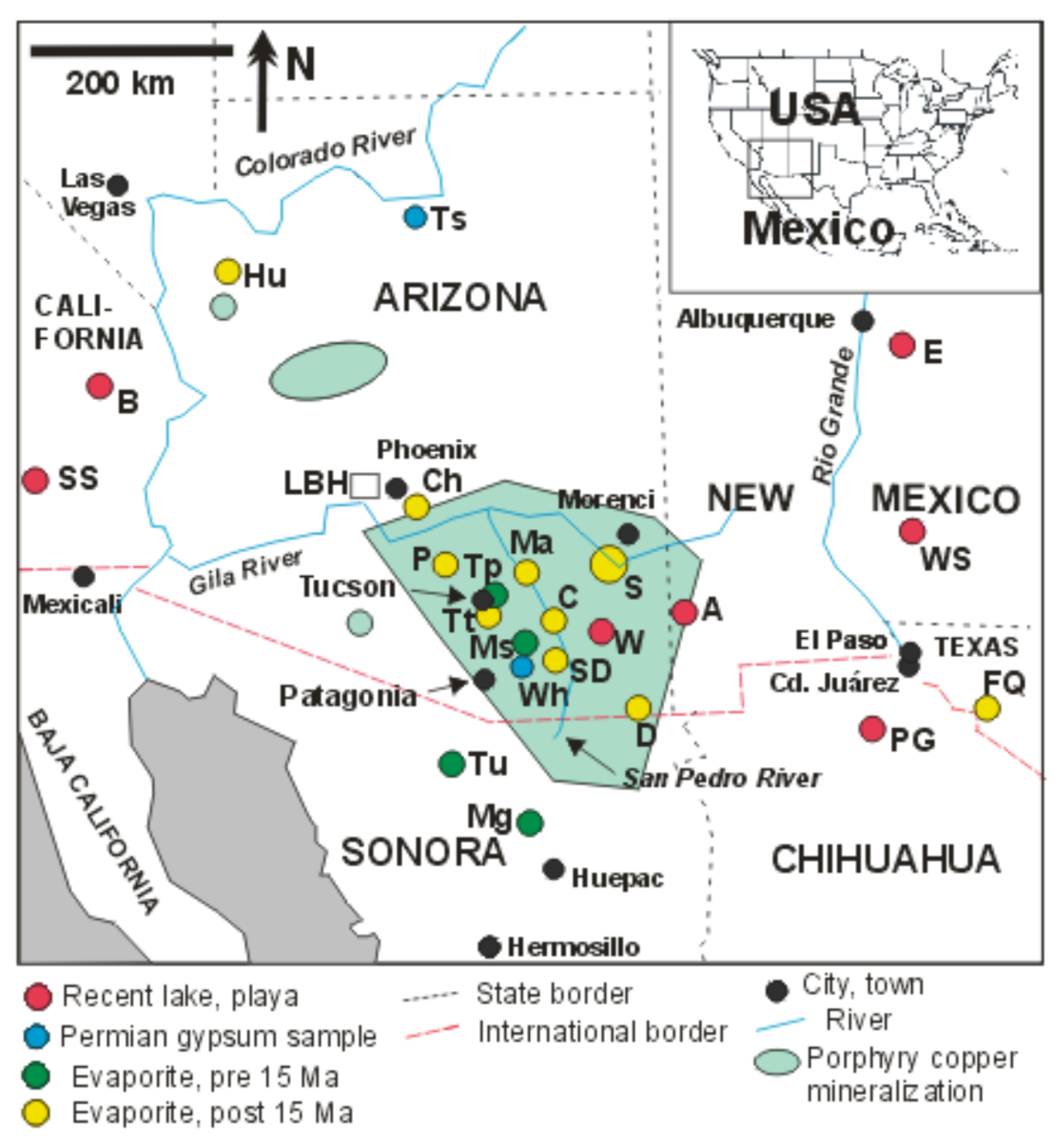
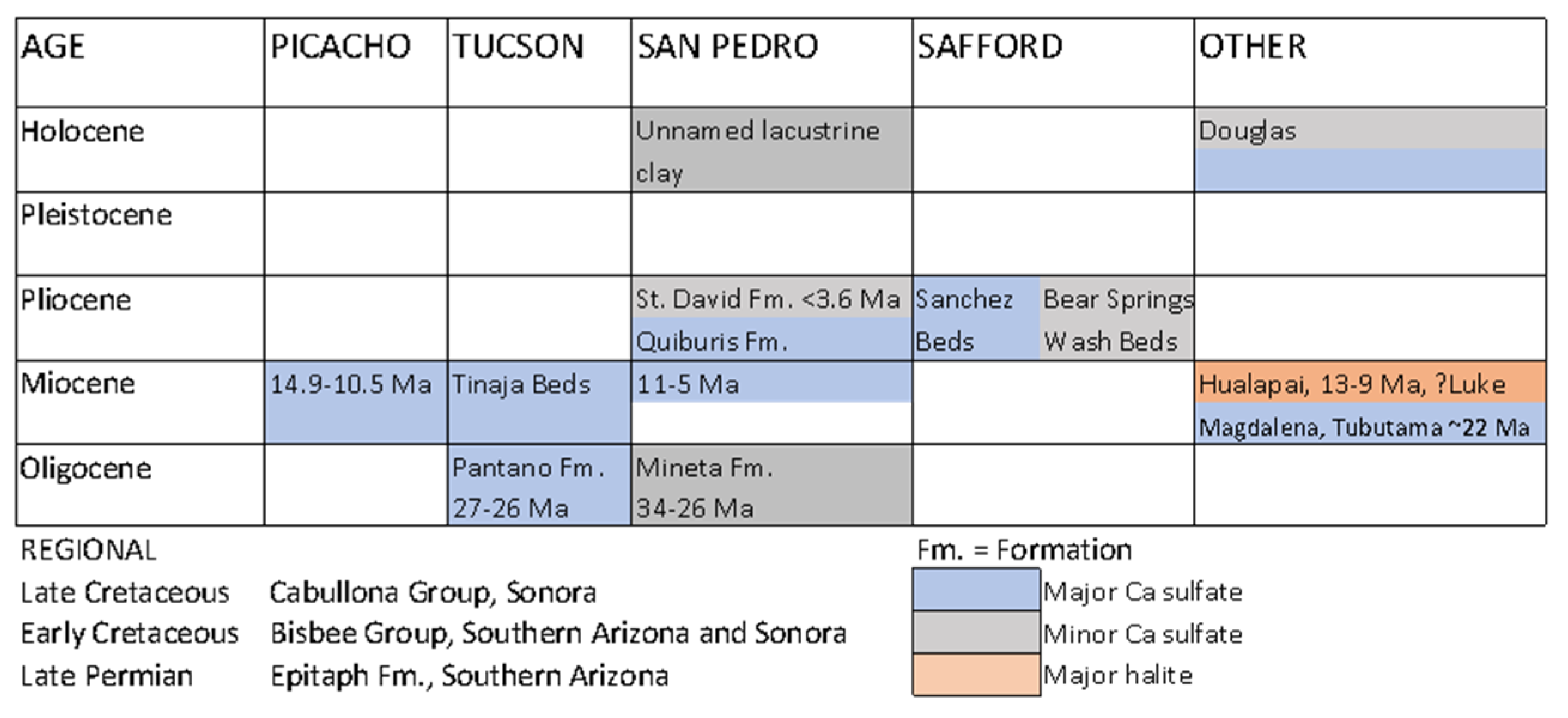


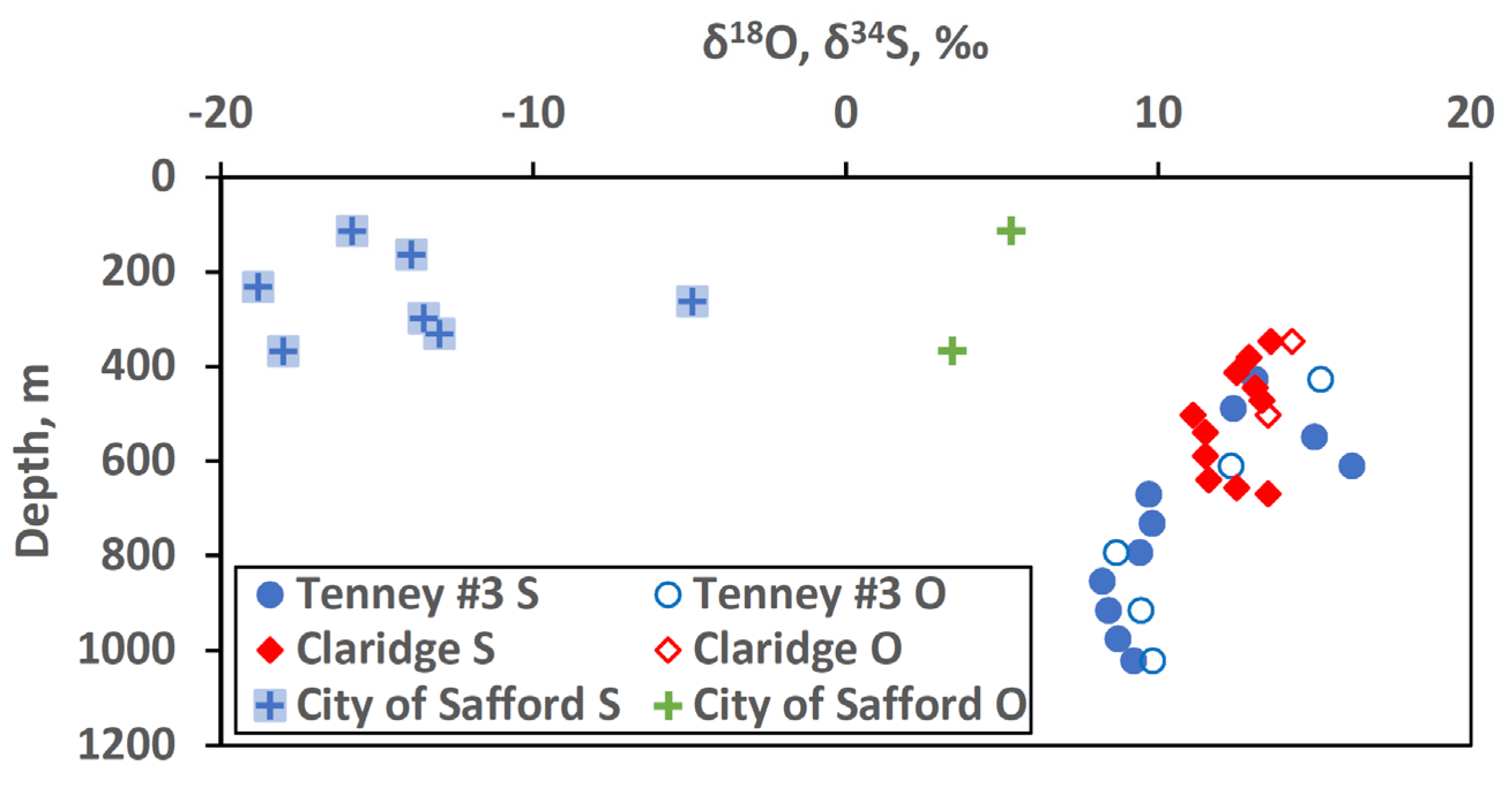
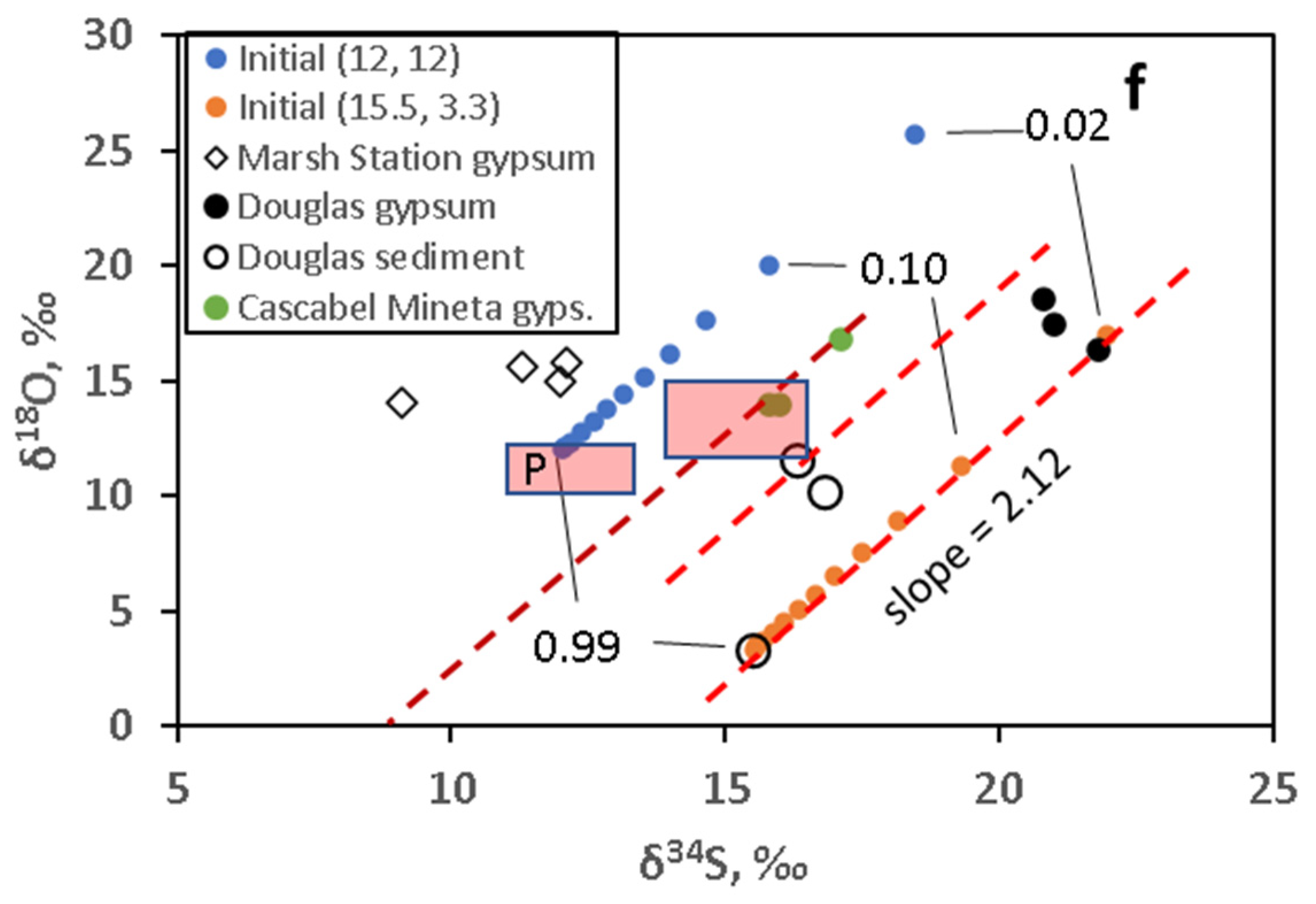

| Mineral | Volume | SG | Concentration | Amount | Mass S | ||
| km3 | 109 t | 109 t | |||||
| Gypsum | 10 | 1.62 | 90% vol * | 14.6 | 2.7 | ||
| Anhydrite | 10 | 2.97 | 90% vol * | 26.7 | 6.2 | ||
| Amount of Source Material Required for 10 km3 of Evaporite | Required per 10 km3 of | ||||||
| Material | Concentration of S, ppm | Mass S | anhydrite | gypsum | |||
| 109 t | |||||||
| Andesite, 10 km3, SG = 2.7 | 60 | 0.0016 # | 3.9 × 104 km3 | 1.7 × 104 km3 | |||
| Giant PCD | 1 | 6 PCDs | 3 PCDs | ||||
| Giant PCD + caprock | 2? | 3 PCDs | 1–2 PCDs | ||||
| Present rainwater, 300 mm/a over 1000 km2 catchment | 0.7 | 0.2/Ma | 31 Ma | 14 Ma | |||
| Required for Picacho anhydrite body | |||||||
| Volume, km3 | Assumed source of S | Amount required | |||||
| 50 | 50% each from Permian gypsum and PCDs | 50 km3 Permian gypsum + 7.5 PCDs | |||||
| 100 | 50% each from Permian gypsum and PCDs | 100 km3 Permian gypsum + 15 PCDs with caprock | |||||
| 50 | 60% each from Permian gypsum, 40% from andesite | 60 km3 Permian gypsum + 0.8 × 105 km3 andesite | |||||
| 100 | 60% each from Permian gypsum, 40% from andesite | 120 km3 Permian gypsum + 1.6 × 105 km3 andesite | |||||
| 50 | 100% from rainwater | 15 Ma over 105 km3 catchment | |||||
| 100 | 100% from rainwater | 30 Ma over 105 km3 catchment | |||||
Publisher’s Note: MDPI stays neutral with regard to jurisdictional claims in published maps and institutional affiliations. |
© 2021 by the authors. Licensee MDPI, Basel, Switzerland. This article is an open access article distributed under the terms and conditions of the Creative Commons Attribution (CC BY) license (https://creativecommons.org/licenses/by/4.0/).
Share and Cite
Gu, A.; Eastoe, C.J. The Origins of Sulfate in Cenozoic Non-Marine Evaporites in the Basin and-Range Province, Southwestern North America. Geosciences 2021, 11, 455. https://doi.org/10.3390/geosciences11110455
Gu A, Eastoe CJ. The Origins of Sulfate in Cenozoic Non-Marine Evaporites in the Basin and-Range Province, Southwestern North America. Geosciences. 2021; 11(11):455. https://doi.org/10.3390/geosciences11110455
Chicago/Turabian StyleGu, Ailiang, and Christopher John Eastoe. 2021. "The Origins of Sulfate in Cenozoic Non-Marine Evaporites in the Basin and-Range Province, Southwestern North America" Geosciences 11, no. 11: 455. https://doi.org/10.3390/geosciences11110455
APA StyleGu, A., & Eastoe, C. J. (2021). The Origins of Sulfate in Cenozoic Non-Marine Evaporites in the Basin and-Range Province, Southwestern North America. Geosciences, 11(11), 455. https://doi.org/10.3390/geosciences11110455







